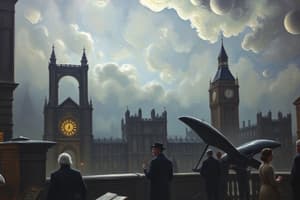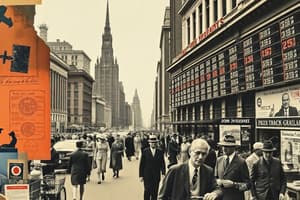Podcast
Questions and Answers
In 1929, more money was spent on _____________________ than education.
In 1929, more money was spent on _____________________ than education.
advertising
In an age of consumerism and capitalism, over how many billion goods are bought on credit?
In an age of consumerism and capitalism, over how many billion goods are bought on credit?
$6 billion
What percentage of Americans had no savings?
What percentage of Americans had no savings?
80%
In October 1929, the stock market loses _____ times more money in three weeks than the government spends in a year.
In October 1929, the stock market loses _____ times more money in three weeks than the government spends in a year.
What percentage of Americans who owned stock were immediately affected by the stock market crash?
What percentage of Americans who owned stock were immediately affected by the stock market crash?
In the last 60 days of 1930, how many banks closed nationwide?
In the last 60 days of 1930, how many banks closed nationwide?
Unemployment in the United States went from ___ million in 1930 to ___ million in 1932.
Unemployment in the United States went from ___ million in 1930 to ___ million in 1932.
How many men were employed for the Hoover Dam, a public works project?
How many men were employed for the Hoover Dam, a public works project?
What is the largest water reservoir created by the Hoover Dam?
What is the largest water reservoir created by the Hoover Dam?
What tiny nearby town boomed due to the construction of Hoover Dam?
What tiny nearby town boomed due to the construction of Hoover Dam?
Describe 'The Dust Bowl.'
Describe 'The Dust Bowl.'
In 1936, U.S. farmers were losing how many million dollars per day?
In 1936, U.S. farmers were losing how many million dollars per day?
How many people fled the Dust Bowl; however, how many stuck it out?
How many people fled the Dust Bowl; however, how many stuck it out?
How did the radio transform America in the 1930s?
How did the radio transform America in the 1930s?
Mount Rushmore was built as part of President Franklin Delano Roosevelt's government program called the ________ Deal.
Mount Rushmore was built as part of President Franklin Delano Roosevelt's government program called the ________ Deal.
Despite the public works programs, in 1936 how many Americans were still unemployed?
Despite the public works programs, in 1936 how many Americans were still unemployed?
What event would it take to get the United States out of the Great Depression?
What event would it take to get the United States out of the Great Depression?
In 1936, how many million Americans listened to the boxing match between Joe Lewis and Max Schmeling on the radio?
In 1936, how many million Americans listened to the boxing match between Joe Lewis and Max Schmeling on the radio?
Who was the winner of the 1936 Heavyweight Title?
Who was the winner of the 1936 Heavyweight Title?
The rematch between Schmeling and Lewis was scheduled for June 22, 1938. What did this fight symbolize?
The rematch between Schmeling and Lewis was scheduled for June 22, 1938. What did this fight symbolize?
Joe Lewis won the rematch in only how many seconds?
Joe Lewis won the rematch in only how many seconds?
What was the symbolism of the Lewis/Schmeling fight?
What was the symbolism of the Lewis/Schmeling fight?
Flashcards are hidden until you start studying
Study Notes
Economic Boom and Bust
- The 1920s experienced a consumer boom; in 1929, more money was spent on advertising than on education.
- Over $6 billion worth of goods were purchased on credit during this consumerist era.
- Approximately 80% of Americans had no savings by the end of the 1920s.
Stock Market Crash
- In October 1929, the stock market lost twelve times more money in three weeks than the U.S. government spent in an entire year.
- Only 2% of the population owned stock and were directly impacted by the crash; the majority continued their daily lives until the collapse of the Bank of the U.S.
Bank Failures and Unemployment
- In the last 60 days of 1930, around 600 banks closed, with 28 states reporting no banks by 1933.
- Unemployment increased drastically from 4 million in 1930 to 12 million in 1932, with 1,000 homes being repossessed daily.
Hoover Dam
- The Hoover Dam project employed 5,000 men and was instrumental in providing water and electricity to the American Southwest.
- Created the largest water reservoir in the U.S., Lake Mead, which allowed California to become an agricultural powerhouse.
Impact on Las Vegas
- The construction of Hoover Dam led to a boom in Las Vegas, a nearby town that increased in population due to construction workers seeking entertainment.
- Today, over 37 million tourists visit Las Vegas annually.
The Dust Bowl
- The Dust Bowl, occurring in 1934, was the worst environmental disaster in U.S. history, characterized by severe dust storms due to drought, high winds, and over-farming.
- The storm’s impact was so severe that it caused street lights in Manhattan to be turned on during mid-day.
- Approximately 250,000 people fled the Dust Bowl, but two-thirds chose to remain despite the hardships.
Economic Struggles of Farmers
- Farmers were losing $25 million per day in 1936 due to the economic fallout from the Dust Bowl and the Great Depression.
Radio's Role in Society
- The radio transformed America in the 1930s by providing comfort and connection, particularly for 40% of the population living in isolated rural areas.
- By 1934, there were 18 million radio sets in use across the country, offering updates on weather, farm prices, and political matters.
New Deal Initiatives
- Mount Rushmore was constructed as part of President Franklin Delano Roosevelt's New Deal programs aimed at economic recovery.
- By 1936, despite these initiatives, 1 in 6 Americans remained unemployed.
Path to Recovery
- World War II was the event that ultimately helped pull the United States out of the Great Depression.
Lewis vs. Schmeling
- The 1936 heavyweight boxing match between African American Joe Lewis and German Max Schmeling drew 57 million listeners, highlighting significant racial and national tensions.
- Lewis represented the hope of African Americans, about 50% of whom were unemployed at that time.
The Rematch
- The rematch on June 22, 1938, at Yankee Stadium symbolized a battle between democracy and dictatorship, captivating 70 million Americans and 100 million worldwide.
Fight Outcomes and Symbolism
- Joe Lewis won the rematch in just 124 seconds, marking the second quickest heavyweight title fight in history.
- The fights between Lewis and Schmeling embodied resilience, symbolizing perseverance through adversity and inspiring hope for many Americans facing the hardships of the era.
Studying That Suits You
Use AI to generate personalized quizzes and flashcards to suit your learning preferences.




